When managing a project, keeping everything organized and on track can feel like herding cats. Deadlines shift, resources get stretched, and teams need a clear picture of what’s next. That’s where a Gantt chart comes in — a powerful visual tool that helps you map out your project from start to finish. With a Gantt chart, you can see every task, milestone, and dependency at a glance, making it easier to stay on course and hit your goals.
But, not all Gantt charts are created equal. The best ones provide clarity, foster collaboration, and adapt to your team’s unique workflows. In this post, we’ll take a closer look at Gantt charts, including how they compare to other types of charts, their benefits, how to make your own, and more.
Whether you’re coordinating a marketing campaign, organizing product launches, or managing client projects, Gantt charts help turn complex processes into streamlined, actionable plans. And with software like monday work management, you can keep everyone aligned — all within a single, intuitive platform.
Get startedWhat is a Gantt chart?
A Gantt chart is a project management tool that visualizes work progress over time against a planned schedule. It typically consists of two main sections: the left side lists all tasks or activities, while the right side features a horizontal timeline with bars representing each task’s duration (which adds up to the entire project duration). These schedule bars clearly show the start and end dates of tasks, making it easy to see what’s in progress, what’s upcoming, and what’s completed.
Gantt charts are popular because they offer a clear, visual way to manage project schedules, helping teams track milestones, deadlines, and task dependencies — how each task connects to and impacts others. With this bird’s-eye view, you can manage complex projects more effectively, ensuring everyone is aligned and on track to meet shared goals.
Who invented the Gantt chart?
The Gantt chart, a cornerstone of modern project management, was invented by Henry L. Gantt, an American mechanical engineer and management consultant, in the early 1900s. Gantt developed this tool to help teams visualize project timelines and manage workflows more effectively. By turning abstract project plans into clear, visual timelines, his chart made it easier to understand the sequence of tasks, track progress, and manage resources.
Gantt’s innovation has stood the test of time, evolving from simple, hand-drawn charts to the dynamic, interactive Gantt charts we use today. Now, with platforms like monday work management, you can harness the power of Gantt charts to plan, execute, and track projects seamlessly — all while adapting to the ever-changing demands of modern work environments.
What is a Gantt chart used for and when should you use one?
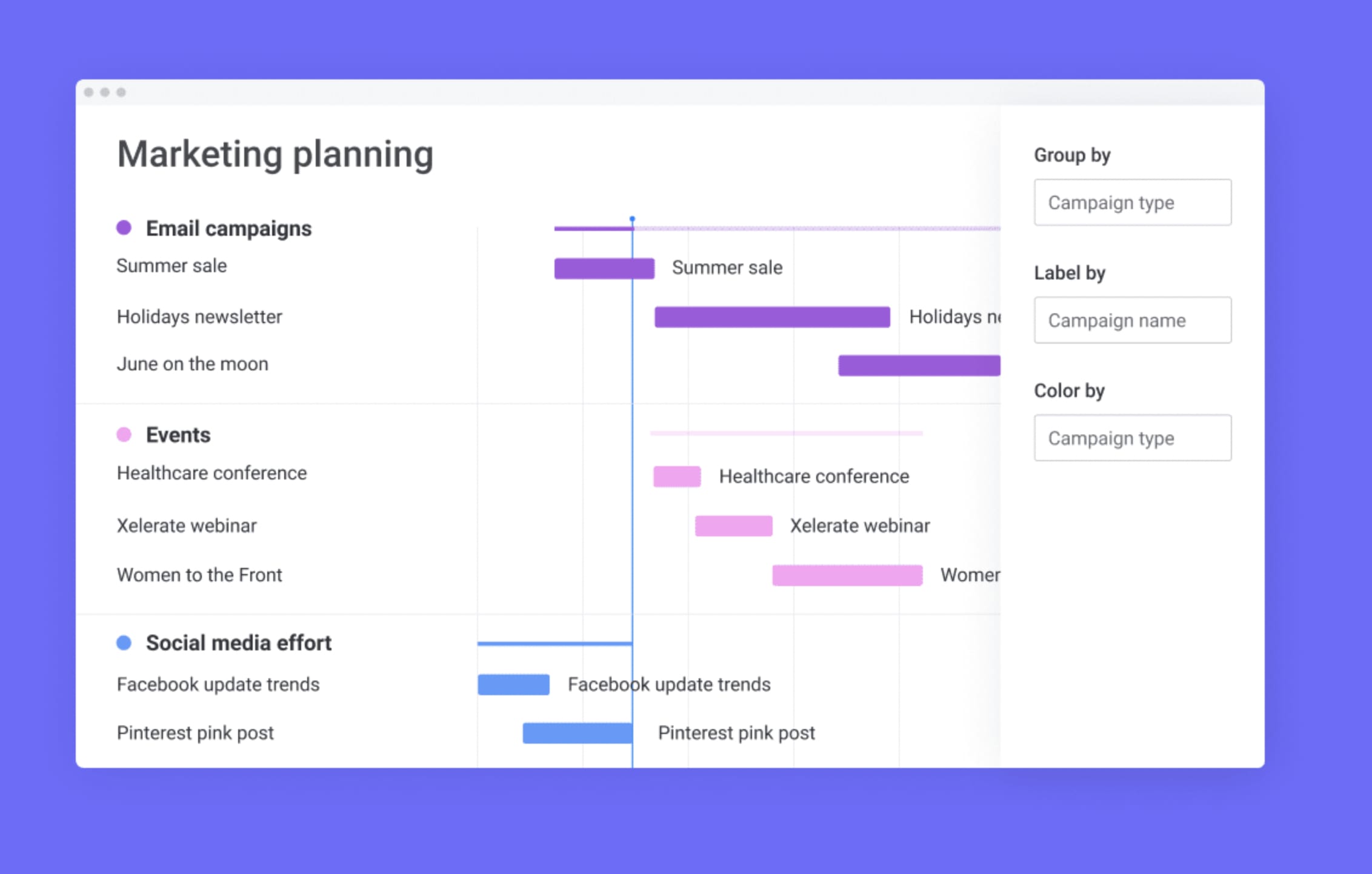
Gantt charts are powerful tools for visualizing project timelines, tracking progress, and managing tasks. They provide a clear, visual overview of what needs to be done, by whom, and when, making them essential for teams managing complex projects.
Here’s how and when to use Gantt charts effectively:
Breaking down and managing complex projects
Gantt charts help break down large projects into smaller, manageable tasks. By scheduling tasks on a timeline with details like start and end dates, assignees, milestones, and dependencies, teams can easily see the entire project’s structure. This approach helps keep everyone aligned on priorities and timelines, from planning a marketing campaign to coordinating a product launch.
Breaking down and managing complex projects
One of the standout features of a Gantt chart is its ability to show task dependencies — the relationships between tasks that affect the project’s flow. For example, if Task B cannot start until Task A is completed, the Gantt chart will visually represent this dependency.
This is crucial for managing logistics in multi-team environments, where delays in one area can impact several other tasks. By visualizing these connections, teams can prevent bottlenecks and keep projects on track.
Tracking project progress and adjusting plans
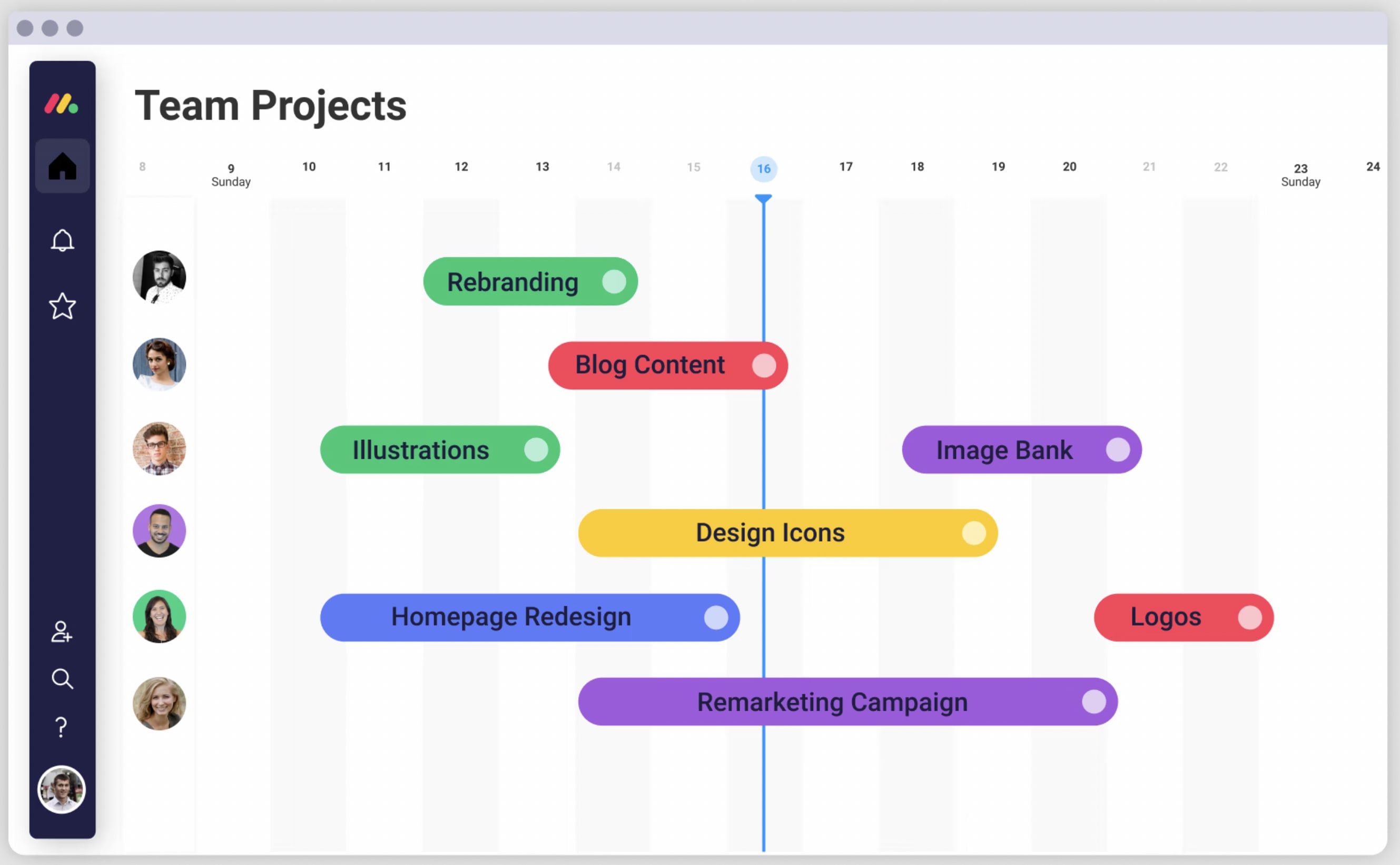
Gantt charts are not just planning tools — they’re also valuable for monitoring progress in real time. As tasks are completed and logged, project managers can quickly assess the project’s health against planned schedules. Visual indicators like release dates, milestones, and completion percentages allow teams to identify potential delays early, adjust workflows, and ensure that projects stay on course.
Coordinating across teams and managing resources
Gantt charts serve as a single source of truth for teams working on multi-phase or multi-team projects. They provide a clear overview of timelines, responsibilities, and objectives, making it easier to coordinate efforts and manage resources efficiently. With a Gantt chart, managers can allocate the right people to the right tasks and adjust as project needs change.
Supporting Work Breakdown Structures (WBS)
Gantt charts work well with a Work Breakdown Structures (WBS), which decompose large goals into smaller, more manageable objectives. While a WBS outlines the scope of work, integrating it with a Gantt chart adds timelines, ownership, and dependencies, creating a comprehensive project plan that drives project success.
What are the components of a Gantt chart?
While every team’s project Gantt chart will look different depending on their unique workflow and critical path, there are six major components that are important to include:
- Dates/times: Gantt charts show task dates from beginning to end as well as their place on the overall project timeline to enable easier planning.
- Tasks and task bars: Tasks and sub-tasks are shown in order of what needs to be completed. Tasks are organized vertically on the left, with bars representing each task shown as a visual bar on a timeline to better view task dependencies over a project’s lifetime.
- Milestones and progress: Certain points of a project are represented as milestones, which on a Gantt chart can look like tasks with a distinct marker. Progress is tracked in relation to how close each phase is to its corresponding milestone, sometimes showing a completion percentage of an ongoing task.
- Dependencies: Arrows or lines are used to denote which tasks are dependent on each other.
- Vertical line markers: Vertical markers indicate the current data of a project on the chart, helping you see where your project is at and how much work is left to do.
- Resources: Some tasks will include resources such as tools, documents, or contacts that are helpful in completing a task.
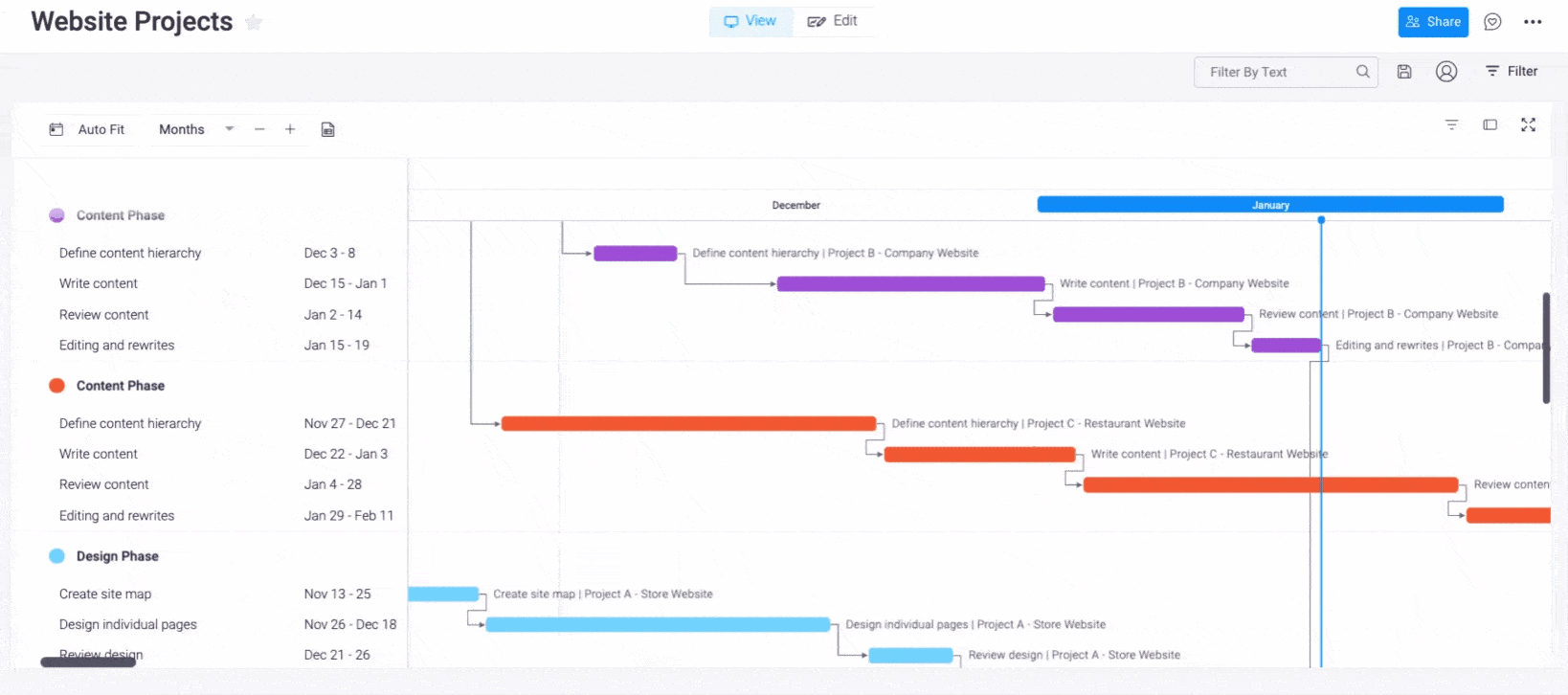
Who uses Gantt charts?
Gantt charts are versatile tools that are widely used by teams and professionals across various industries. From project managers and team leads to marketers and operations specialists, anyone looking to keep their projects on track can benefit from Gantt charts. They help:
- Project managers plan, schedule, and assign tasks, ensuring everyone is aligned and aware of dependent tasks and deadlines.
- Marketing teams coordinate campaigns, manage resources, and track progress across multiple channels — from social media to content creation.
- Product development teams visualize product roadmaps, track release timelines, and manage cross-functional workflows to bring products to market faster.
- Construction managers outline project phases, track deliverables, and manage subcontractors, ensuring projects are completed on time and within budget.
- Event planners map out every detail from logistics to marketing, coordinating with vendors and stakeholders to deliver successful events.
- Retail teams manage store openings, promotions, and inventory planning, ensuring all activities are synchronized for maximum impact.
- Media and production teams organize content calendars, coordinate shoots, and manage post-production schedules to ensure deadlines are met and content is delivered on time.
No matter the field, Gantt charts provide a clear, visual way to manage complex projects and keep teams moving in the right direction.
Gantt chart examples
Gantt charts are incredibly adaptable and can be used in various industries to bring clarity, organization, and efficiency to complex projects. Let’s explore how different industries use Gantt charts to streamline their workflows and achieve their goals.
How retail companies can utilize Gantt charts
Retail companies often juggle multiple projects at once, from planning new store openings and seasonal promotions to managing inventory and visual merchandising. Gantt charts offer a clear, visual way to manage these overlapping tasks, helping retail teams streamline their workflows and hit their targets.
Use case: For launching a new store, a Gantt chart can break down every phase of the project — from securing permits and organizing inventory to training staff and rolling out marketing campaigns. Each task is plotted on a timeline, showing its start and end date, dependencies, and who is responsible.
Benefits: With a Gantt chart, retail teams can ensure tasks are completed on schedule, manage dependencies effectively, and allocate resources where they’re needed most. This level of organization keeps everyone aligned, from store managers to marketing teams, and helps prevent delays — ensuring a smooth and successful store launch.
How media teams can optimize workflows with Gantt charts
Media and production teams thrive on tight schedules, fast turnarounds, and multi-layered content calendars. Gantt charts help these teams stay on top of every phase of production, from brainstorming and scripting to shooting, editing, and distribution.
Use case: For a multimedia campaign, a Gantt chart can be used to outline all tasks, such as scriptwriting, filming, post-production, and channel-specific content distribution. This structured view allows for real-time adjustments and efficient task management.
Benefits: By using Gantt charts, media teams can instantly see where each piece of content stands in the production process, identify potential bottlenecks, and adjust schedules as needed. This not only ensures timely delivery but also reduces the risk of costly delays and helps keep the entire team in sync.
How construction projects benefit from Gantt charts
Construction projects are often complex, involving numerous stakeholders, detailed planning, and strict deadlines. Gantt charts provide construction managers with a comprehensive overview of all project phases, from site preparation to the final handover, helping them manage resources and timelines effectively.
Use case: For a commercial building project, a Gantt chart can outline tasks from pre-production to post-production, including design approvals, foundation work, structural development, and finishing touches. Each task is clearly defined with its duration and dependencies, providing a visual roadmap for the entire project.
Benefits: Gantt charts give construction managers the visibility needed to allocate resources efficiently, manage subcontractors, and monitor progress against deadlines. This helps prevent delays, manage risks proactively, and ensure that the project stays within budget and scope, leading to successful project completion.
How to create a Gantt chart
Get startedCreating a Gantt chart from scratch requires several steps, from gathering all the different tasks and subtasks to defining dependencies, and creating a horizontal timeline. While this can be done independently, it’s a lot easier to start with the help of a project management platform with built-in Gantt chart views and templates, like monday work management.
Step 1: Define your project scope and tasks
Before diving into your Gantt chart, start by outlining the entire scope of your project. Identify all the major tasks and subtasks that need to be accomplished to complete the project. Think of each phase of the project and break it down into smaller, actionable steps.
Step 2: Establish task durations and deadlines
Once you have a clear project task list, determine how long each task will take to complete. Assign start and end dates for each task based on the project timeline. This helps in setting realistic deadlines and planning resources effectively.
Step 3: Identify task dependencies
Tasks in a project are often interconnected. Use your Gantt chart to visualize which tasks depend on others. For example, task B cannot start until task A is complete. Identifying these dependencies is crucial for a smooth workflow and helps prevent bottlenecks later.
Step 4: Allocate resources and assign task owners
Determine who will be responsible for each task. Assigning task owners helps establish accountability, ensures everyone knows their role, and provides a clear view for more efficient resource management. In monday work management, you can easily assign team members to tasks directly on your Gantt chart, making it clear who is responsible for what.
Step 5: Build your Gantt chart timeline
Now that you have all the information ready, it’s time to visualize it. Use monday work management to create your Gantt chart with just a few clicks. Start by adding your tasks, setting durations, and linking dependencies. You’ll see your project timeline take shape, providing a clear, visual overview.
Step 6: Customize your Gantt chart view
Every project is unique, so customize your Gantt chart to fit your team’s needs. Use colors, labels, and filters to highlight important milestones, deadlines, or critical paths. With monday work management, you can add widgets to your dashboard for a high-level overview or zoom into specific tasks for more detail.
Step 7: Monitor progress and make adjustments
A Gantt chart is a living document that needs to be updated as your project progresses. Track task completion, monitor timelines, and adjust as needed if deadlines shift or new tasks arise. With monday work management, updates are easy — you can make changes directly on your Gantt chart, keeping everyone on the same page.
Step 8: Share your Gantt chart with stakeholders
Finally, share your Gantt chart with team members, clients, or stakeholders to keep everyone informed and aligned. monday work management allows you to easily share your Gantt chart views and customize what each viewer can see, ensuring the right level of transparency and collaboration.
How to view your tasks on a Gantt chart with monday work management
monday work management offers over 27 project views to view your tasks, with a Gantt chart being one of them. That means that instead of creating the chart from scratch, all you need to do is create your workboard, including all the parameters you’d like such as columns and automations, and then in a few clicks, you can view it as a Gantt chart. Here’s how it works:
- Make sure your board has a Timeline Column and Dependency Column.
- In the Board View menu, select Gantt
- Your tasks are now organized in one Gantt chart and you can get more creative with on-the-fly edits and cool features like The Gantt Baseline, which allows you to visualize your current project’s progression against the planned timeline
Once your Gantt view is created in monday work management, you can then customize it to your liking. You can add it as a widget to your dashboard so it’s easily accessible, customize which columns from your board appear in your chart, and view items in your chart by group such as project phases. You can also play with visual settings by adding labels or specific colors to items on your chart.
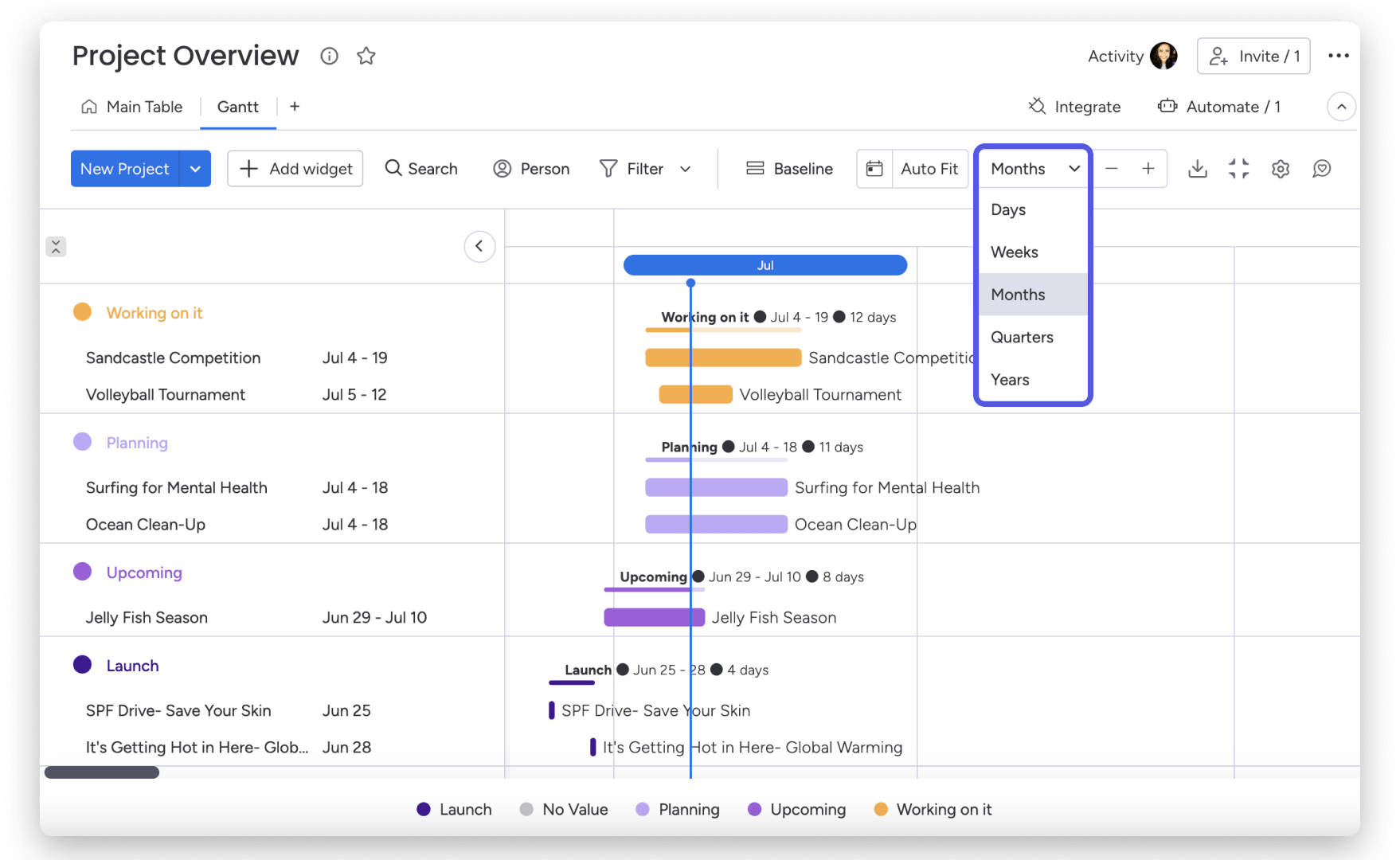
monday work management also allows you to zoom in or out of your Gantt chart by customizing the time frame. For example, you can choose to view your chart in days, weeks, months, years, or quarters, allowing you to zoom in and small tasks and then get a complete project overview in a few clicks.
With monday work management, you get the flexibility in visualizing your work how you want. While tasks start out on a board, you don’t need to go back to the board view from your Gantt chart to continue updating your project. If you prefer working primarily with a Gantt chart, you can update items directly from the Gantt view without toggling back and forth.
How to use Gantt charts to manage projects more effectively
Gantt charts are a go-to solution for keeping projects on track, boosting collaboration, and ensuring transparency across teams. Here are some best practices and tips to help you get the most out of your Gantt charts:
- Centralize communication and collaboration: Keep all project-related discussions, files, and updates in one place. Use Gantt charts to add comments directly to tasks, tag team members for quick responses, and share critical details upfront to avoid any confusion. This eliminates scattered communication and ensures everyone stays on the same page.
- Attach important files to tasks: Make sure all the necessary documents are easy to find by attaching them directly to relevant tasks. This can include briefs, mockups, design files, or client feedback. Having everything in one place saves time and reduces the risk of working with outdated versions.
- Visualize project dependencies and prevent bottlenecks: Use your Gantt chart to map out project and task dependencies and visualize the sequence of work. This helps you anticipate potential roadblocks and adjust schedules proactively, ensuring smooth transitions from one task to the next.
- Monitor project progress in real-time: Keep an eye on task completion and milestone achievements. Regularly updating your Gantt chart allows you to track progress in real-time, spot delays early, and make informed decisions to keep the project moving forward.
- Share your Gantt chart with stakeholders: Transparency is key to building trust and ensuring alignment. Share your Gantt chart with external stakeholders, like clients or contractors, by granting them guest access, sending a view-only link, or exporting it as a PDF. This allows them to stay updated without overwhelming them with unnecessary details.
- Use visual elements to enhance clarity: Leverage color-coding, labels, and icons to highlight critical paths, deadlines, or priority tasks. Visual cues make it easy for team members to quickly grasp key information and understand what requires immediate attention.
- Set clear task ownership and accountability: Assign tasks to specific team members and set deadlines. Clearly defined responsibilities help eliminate ambiguity, keep everyone accountable, and ensure that no task falls through the cracks.
- Incorporate regular check-ins and updates: Use your Gantt chart during team meetings to provide status updates and adjust timelines. This fosters a collaborative environment where everyone can contribute to solving challenges and keeping the project on track.
- Leverage automations to streamline processes: Automate repetitive tasks such as status updates, notifications, or dependencies. This reduces manual effort and helps teams focus on high-impact activities that drive the project forward.
The pros and cons of using a Gantt chart in project management
There are many reasons why project managers would turn to a Gantt chart for organizing projects. Gantt charts provide teams with a number of benefits that make collaborating on tasks and getting project updates easier. Let’s take a look at a few of the benefits of using a Gantt chart in project management:
- Gantt charts help teams understand a critical path by identifying task dependencies
- Project managers can better allocate resources effectively by viewing the start and end date of each task and identifying conflicts in in resource scheduling
- Gantt charts provide team members with a clear and visual representation of a project and its schedule, helping everyone with project schedule management
- Track the progress of multiple tasks and compare them against the planned schedule to identify potential delays or bottlenecks and improve time management
- Task ownership is more apparent as team members are assigned tasks and know their responsibilities and deadlines
- Project managers can identify potential risks and create measures accordingly by visualizing task dependencies and critical paths
- Gantt charts facilitate communication with team members, clients, and stakeholders and help manage expectations while providing a clear overview of project progress
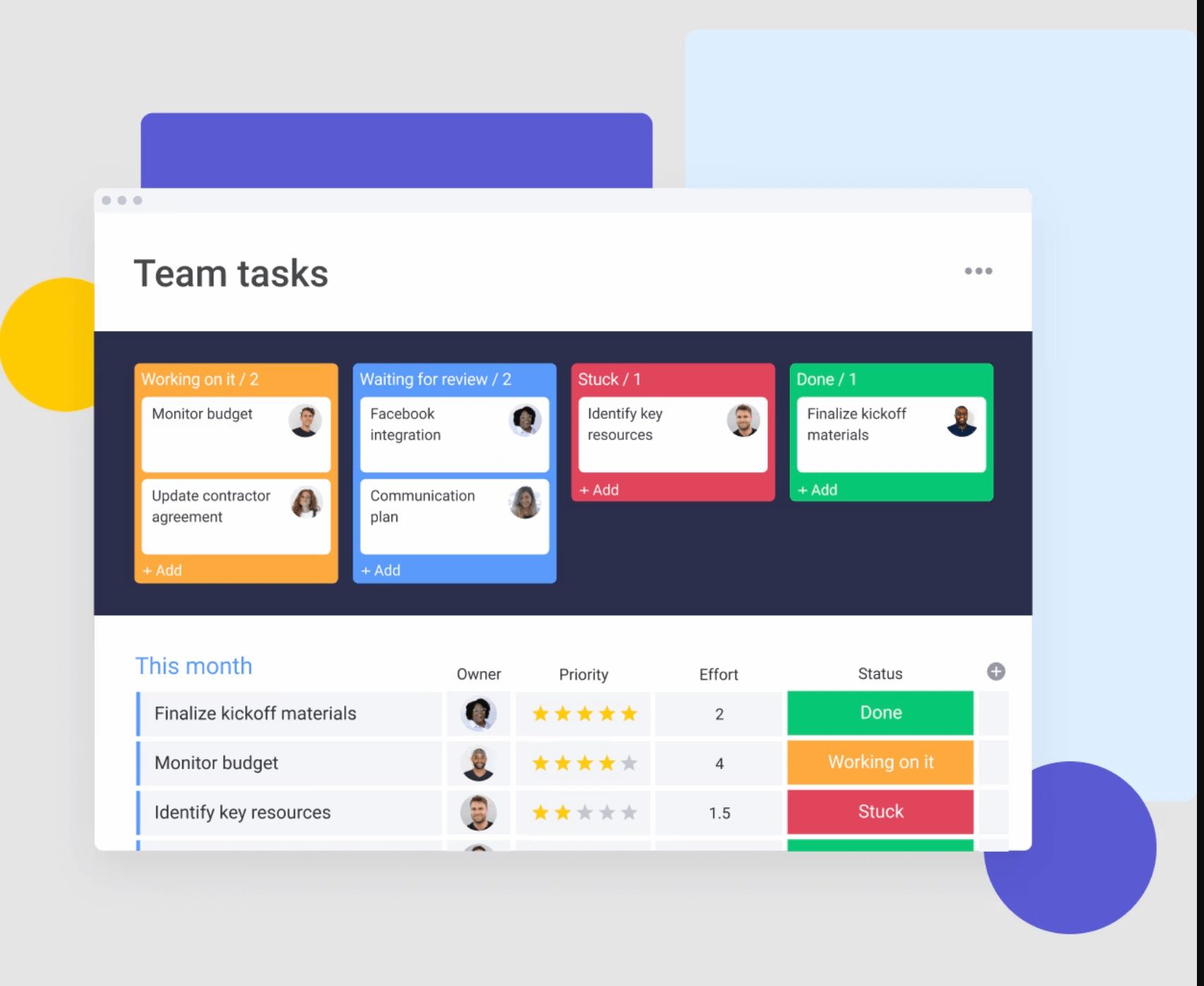
Drawbacks of Gantt charts
While the benefits of Gantt charts are undeniable, they’re not always the best fit for every team or project. Additionally, Gantt charts also have a few drawbacks that are important to be aware of:
- Gantt charts can get complex and challenging when it comes to larger and more detailed projects with many tasks.
- Maintaining an up-to-date Gantt chart can be cumbersome and time-consuming when changes arise. Without careful management of resources, Gantt charts can potentially overload team members with multiple tasks.
- Team members who aren’t familiar with Gantt charts may experience a somewhat steep learning curve to be able to fully understand and use them effectively. Some Gantt charts may not include all necessary information for tasks, such as descriptions or required resources, leading to delays.
There are several Gantt tools, like monday work management, that allow you to manage projects using Gantt charts that help you avoid these drawbacks through automations, integrated communication tools, and more.
Some projects can benefit from different types of visualizations. Gantt charts aren’t the only way to view a project and its tasks, and depending on factors like the size of your team, your timeline, and the nature of your project, you might want to consider a Gantt chart alternative.
Not sure which Gantt chart software is right for you? We’ve compiled a list of the best Gantt chart software options to help you find the perfect fit. Each one offers unique features and capabilities to cater to different team needs, so you can choose the tool that aligns best with your workflow and goals.
Get startedGantt chart alternatives
While Gantt charts can be beneficial for many types of projects, they’re not always the best option for every team. There are many other types of project management charts, boards, and tools, each with a unique approach to project visualization and management. Some popular alternatives include:
- Kanban board: Kanban boards rely on cards to visually represent tasks and columns as stages of a workflow. Team members move the cards from one column to another as tasks progress, providing a clear overview of status and workflow.
- Scrum board: Used in Agile project management, Scrum boards are designed for iterative development. They visualize user tasks in a backlog and display their progress through different stages during each sprint.
- Timeline chart: Project timeline charts provide a simple and linear representation of tasks and events over a set time. While less detailed than Gantt charts, they provide a quick overview of a project’s significant milestones.
- Project checklist: Project checklists are simple, straightforward, and have no learning curve, making them easily adaptable to any team. They can be used on their own or in conjunction with other charts and boards.
Pert chart vs Gantt chart
In a PERT chart (Program Evaluation and Review Technique), tasks are represented in a network diagram that includes nodes or circles with arrows between them to demonstrate dependencies between tasks. While both Gantt and PERT charts are important project management tools, there are some key differences between the two, such as where they focus, task dependencies, complexity, and critical path.
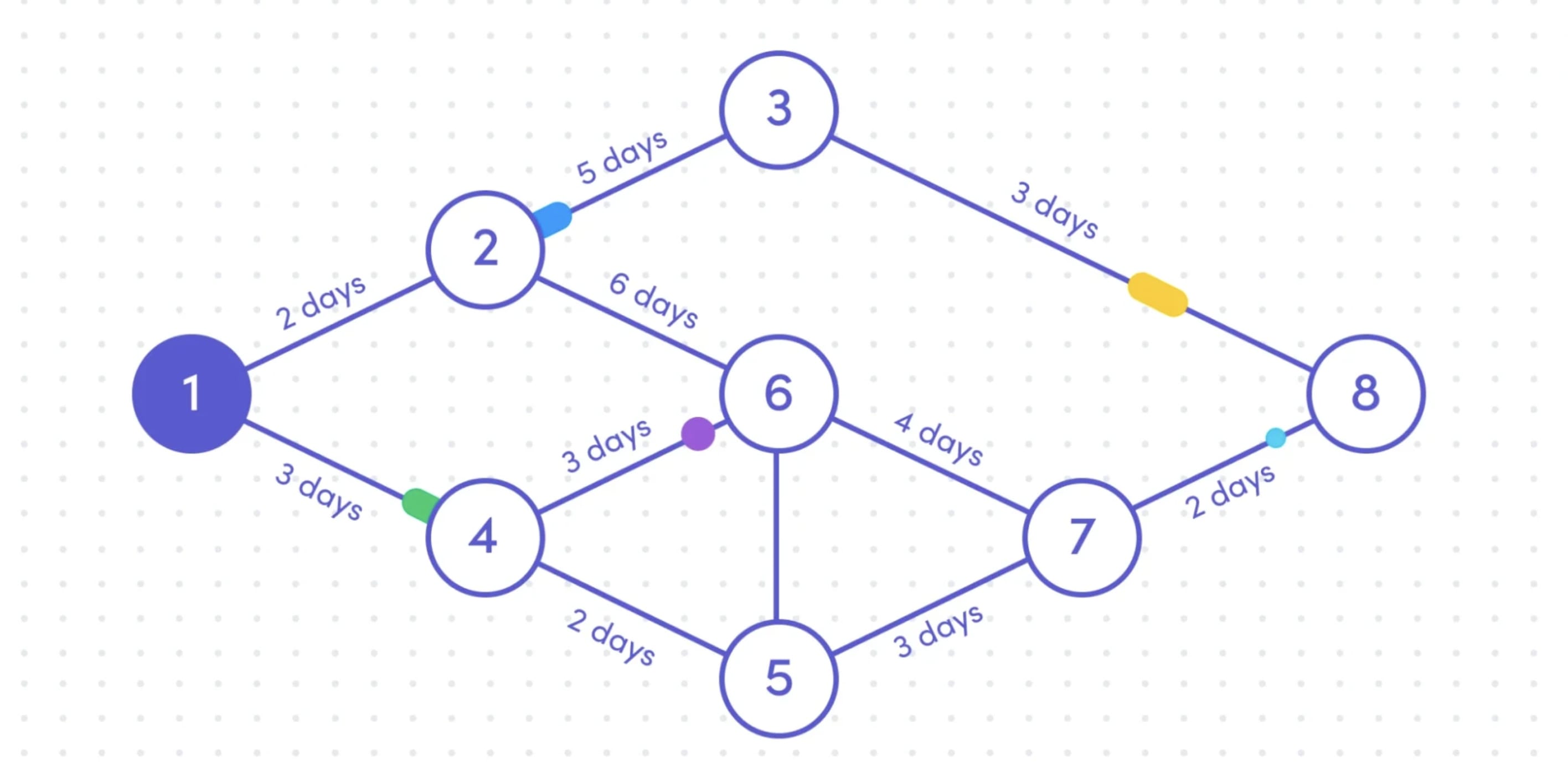
Overall, PERT charts better depict task interdependencies and critical path analysis for complex projects, while Gantt charts emphasize task scheduling and progress tracking for a range of project sizes and types. That’s not to say both charts can’t be applied to the same project, but in general, PERT chats are ideal for the planning phase while Gantt offers more flexibility and adaptability throughout project implementation.
Sometimes, it can even be helpful to employ more than one type of view in your project. Platforms like monday work management allow you to choose from over 27 project views, so you’re never limited to just one option and each team member can benefit from their preferred view.
Get startedStart creating your Gantt chart
To wrap things up, you can see that Gantt charts present a useful way to visualize projects, and with the advent of Gantt chart software, they can take your team’s processes to the next level.
However, not all project management software solutions are created equal.
The most sophisticated solutions, like monday work management, offer advanced features like different chart views, customizable automations, integrations, and the ability to filter the information you included.
So, if you are looking for a visual solution that can manage projects of all sizes and industries, plus a robust Gantt chart, you may find monday.com is just what you’re looking for.
Be sure to check out our easy-to-use Gantt chart template!
FAQs
How do you make a Gantt chart in Excel?
Creating a Gantt chart in Excel involves a few manual steps to set up and format a horizontal bar chart:
Select your data: Start by entering your project’s tasks, start dates, and durations in an Excel spreadsheet.
Insert a bar chart: Highlight your data, go to the Insert tab, and choose a Stacked Bar Chart.
Format the chart for Gantt view: Adjust the bar chart by hiding the task start date bars and formatting the remaining bars to show task durations, creating the appearance of a Gantt chart.
While Excel can be a quick way to create a basic Gantt chart, it requires time-consuming formatting to get it right and lacks advanced features like task dependencies, real-time collaboration, and automatic updates.
A more efficient option is to use dedicated project management software like monday work management, which offers a built-in Gantt View. With just a few clicks, you can add a Gantt chart to any board, customize it to fit your project needs, and leverage powerful features like automations, dependencies, and team collaboration — all without the hassle of manual formatting.
Is a Gantt chart a timeline?
While used for similar functions, the main difference between the two is that a timeline organizes events in a single line and a Gantt chart is two-dimensional and includes details like dependencies. However, they both provide stakeholders with high-level overviews of start and end dates and key milestones in a project.
What three things are included in a Gantt chart?
A Gantt chart typically includes three key elements:
Tasks: A list of tasks or activities that need to be completed within the project.
Timeline: A horizontal timeline that shows the start and end dates for each task.
Dependencies: Visual indicators (like arrows or lines) that show the relationship between tasks and how they depend on each other to progress.
These elements help teams plan, visualize, and manage projects efficiently by providing a clear picture of what needs to be done and when.
Are Gantt charts easy to make?
Creating a basic Gantt chart can be straightforward, especially with the right tools. While platforms like Excel require manual formatting, advanced project management software like monday work management makes it easy to create, customize, and update Gantt charts in just a few clicks. With features like drag-and-drop editing, automatic updates, and pre-built templates, you can focus more on managing your project and less on the setup.
What does Gantt stand for?
"Gantt" doesn’t stand for anything — it’s the last name of Henry Gantt, the American engineer and management consultant who invented the Gantt chart in the early 1900s. His innovation has become a staple in project management for visualizing timelines and keeping teams on track.
Is there something better than a Gantt chart?
While Gantt charts are excellent for visualizing project timelines and managing task dependencies, other tools might be better suited for specific needs. For example:
Kanban boards are great for teams that need to manage workflows and visualize tasks in progress.
Scrum boards work well for Agile teams focusing on iterative development.
Calendar views offer a straightforward way to manage deadlines and events.
The best tool depends on your team's workflow, project complexity, and collaboration needs. With monday work management, you’re not limited to just one view — you can switch between Gantt charts, Kanban boards, timelines, and more to manage projects your way.
